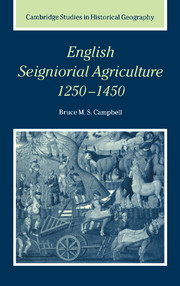Book contents
- Frontmatter
- Contents
- List of figures
- List of tables
- Preface and acknowledgements
- Abbreviations
- Weights, measures, values, and boundaries
- 1 Introduction: agriculture and the late-medieval English economy
- 2 Sources, databases, and typologies
- 3 The scale and composition of the seigniorial sector
- 4 Seigniorial pastoral production
- 5 Seigniorial arable production
- 6 Crop specialisation and cropping systems
- 7 Arable productivity
- 8 Grain output and population: a conundrum
- 9 Adapting to change: English seigniorial agriculture 1250–1450
- Appendix 1 Demesne-level classification of husbandry types
- Appendix 2 Demesnes represented in the Norfolk accounts database
- Appendix 3 Demesnes represented in the FTC accounts databases
- Consolidated bibliography
- Index
- Cambridge Studies in Historical Geography
2 - Sources, databases, and typologies
Published online by Cambridge University Press: 20 October 2009
- Frontmatter
- Contents
- List of figures
- List of tables
- Preface and acknowledgements
- Abbreviations
- Weights, measures, values, and boundaries
- 1 Introduction: agriculture and the late-medieval English economy
- 2 Sources, databases, and typologies
- 3 The scale and composition of the seigniorial sector
- 4 Seigniorial pastoral production
- 5 Seigniorial arable production
- 6 Crop specialisation and cropping systems
- 7 Arable productivity
- 8 Grain output and population: a conundrum
- 9 Adapting to change: English seigniorial agriculture 1250–1450
- Appendix 1 Demesne-level classification of husbandry types
- Appendix 2 Demesnes represented in the Norfolk accounts database
- Appendix 3 Demesnes represented in the FTC accounts databases
- Consolidated bibliography
- Index
- Cambridge Studies in Historical Geography
Summary
Sources
Seigniorial producers invite separate historical study because they alone kept detailed records of their agricultural activities. The size, composition, and value of demesnes held by lay tenants-in-chief are also the subject of separate records kept by the crown. The combined documentary legacy which this has bequeathed is without peer or parallel in the annals of European agrarian history. Such is the quality and quantity of these sources – notably manorial accounts, but also extents and a variety of other estate and manorial records — that the seigniorial sector is the obvious starting point for any systematic analysis of medieval agriculture as a whole. Perhaps 25–30 per cent of all agricultural land was held by lords in demesne. How that land was worked and what it produced are consequently issues of considerable significance in their own right, but spatial and temporal trends within the seigniorial sector also imply much about developments within the wider agrarian economy, including the technological proficiency and productivity potential of agriculture. Moreover, the fuller picture that can be reconstructed of the seigniorial sector helps to make better sense of the more miscellaneous and fragmentary material pertaining to other classes of producer – glebe owners, large freeholders, virgators and other substantial customary tenants, and the host of lesser free and unfree peasants.
Manorial accounts
No single source provides fuller, more systematic, and more precise information on the practice, performance, and profits of husbandry than the annual accounts rendered at the end of each farming year – sometimes at Lammas (1st August) but usually Michaelmas (29th September) – by the reeves and bailiffs of individual manors.
- Type
- Chapter
- Information
- English Seigniorial Agriculture, 1250–1450 , pp. 26 - 54Publisher: Cambridge University PressPrint publication year: 2000



